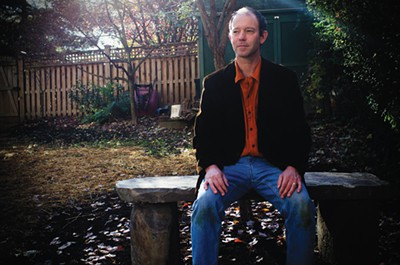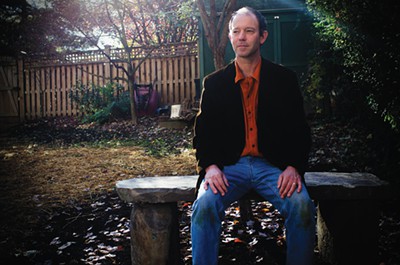This story originally appeared in Urbanite.
 In What’s Gotten Into Us? Staying Healthy in a Toxic World, McKay Jenkins sounds an alarm on the chemicals that we unknowingly ingest and inhale daily.Photo: J.M. GiordanoAfter the discovery of a tumor near his hip, McKay Jenkins, married, father of two, began investigating the manufacturing and consumer use of synthetic chemicals, particularly those in everyday products such as plastic bottles, cosmetics, toys, carpets, and cell phones. His search eventually lead to a book, published by Random House in April, called What’s Gotten Into Us? Staying Healthy in a Toxic World.
In What’s Gotten Into Us? Staying Healthy in a Toxic World, McKay Jenkins sounds an alarm on the chemicals that we unknowingly ingest and inhale daily.Photo: J.M. GiordanoAfter the discovery of a tumor near his hip, McKay Jenkins, married, father of two, began investigating the manufacturing and consumer use of synthetic chemicals, particularly those in everyday products such as plastic bottles, cosmetics, toys, carpets, and cell phones. His search eventually lead to a book, published by Random House in April, called What’s Gotten Into Us? Staying Healthy in a Toxic World.
Jenkins, a professor of English and journalism at the University of Delaware, says he wanted What’s Gotten Into Us? to be similar to Michael Pollan’s book The Ominivore’s Dilemma: “The book sets out to open people’s eyes about the connection of many consumer products to their health, the environment, workers’ rights,” he says.
“Flame retardants are found in women’s breast tissue; hormone disrupters in the drinking water,” he says. And although it is impossible to conclude directly, they are likely linked to increasing rates of some cancers, reproductive problems, learning disabilities, and other health issues.
We asked Jenkins what he thinks we ought to know, and what’s being done about it.
Q. Jumping off the page early in What’s Gotten Into Us? are the references to body-burden studies, where researchers test people’s bodies for the presence of synthetic chemicals such as plasticizers, pesticides, and flame retardants.
A. There are a variety of different groups — some are environmental groups with a legislative agenda, others interested in science and policy — that hire outside researchers. So I decided to go to Maine where some of this work was being done. People submit blood, hair, and urine. The evidence points to the ubiquity of these chemicals, not in laboratories, rivers, or lab rats, but literally, they find them in people.
Other studies have found them in wild animals, the breast tissue of Beluga whales, atop of South American mountains, and in the bodies of the Inuit in the Arctic Circle. The wind literally blows [synthetic chemicals] around the world. They don’t go away.
Q. Many of those who tested positive in the Maine study grew up in remote, rural areas. On average, you report, participants harbored 36 toxic chemicals, including traces of chemicals used to make Teflon and Scotchgard treatments. The body-burden studies themselves are a new tactic, correct?
A. Calling [the spread of these chemicals] an environmental issue has not gotten traction. Calling it a health issue has not been effective. Calling it a health issue that affects kids — that works. The political driver tends to be moms because it’s not just their own health, but also the health of their kids, for women of childbearing age.
Q. What about federal studies?
A. The CDC [Centers for Disease Control and Prevention] has ongoing national studies. They can be aggravatingly non-political. They’ll note the existence of certain chemicals, but don’t say, “Therefore, we should ban it.” And industry exploits that.
Q. Was the discovery that Bisphenol-A (BPA) was leeching from reusable, environmentally righteous Nalgene bottles a canary-in-the-coal-mine moment?
A. It’s interesting. Out of the thousands of chemicals that may harm people, why would it be that BPA popped to the surface [of media attention]? Was it that BPA was also used for things like baby bottles and heated liquids caused it to leech faster? “Oh god, the heated bottle on the stove in middle of the night? I might be giving hormone disrupting chemicals to a baby.” That’s a resonant image.
What about stain resistant carpeting? Why not that? And BPA is still being used, just not in baby products. The chemical industry wants chemicals regulated chemical-by-chemical, state-by-state, for babies, not for babies, for adults, not for adults. They don’t give in. It’s inch by inch.
Q. You also write about pesticides, petrochemicals, and pharmaceuticals — traces of everything from anti-depressants to Viagra — entering the water supply.
A. The water treatment systems we have in place are not technologically advanced enough to address the problems we have. We’re used to dumping a bunch of chlorine in there. On the East Coast [treatment plants] were built 150 years ago to combat cholera and dysentery, which they do well … [But] these contaminants can’t be killed.
Q. As part of the research, you invited a Johns Hopkins toxicologist into your home for a walk-through. What did he suggest removing?
A. The biggest problem was the old lacquer, paint cans, and sealants we had in the basement for the past six years after remodeling. We never had Teflon pans; we use steel pans with olive oil. Definitely not wall-to-wall carpeting.
The biggest change for me was the lawn — replacing about 20 percent of the grass with native plants, trees, and bushes. Pesticide users destroy the bird population. We planted blueberry bushes, black-eyed Susans, milkweed, butterfly weed. Eventually, we had gold finches, multiple species of butterflies, humming birds coming around. What was interesting, too, is that then kids in the neighborhood started coming over to see what was happening.
Q. What’s been the reaction to the book?
A. There have been two for the most part. “God, I don’t want to read that,” has been one of the strongest reactions, and something we’ve had to overcome in marketing the book. Consciously, people don’t want to know what chemicals are being used in their cosmetics, green lawns, microwave popcorn …
The second-biggest reaction has been, they want simple answers and an appendix with 3,700 things to do. There is an appendix, but what I was interested in is why and how we got to this place. There are 50 million acres — the size of Nebraska — of lawn in this country. How did this come about? How did it come to be that our houses had to smell like lavender or apple pie? Rather than baking an apple pie, a company will sell you a synthetic spray that smells like apple pie.
Q. As a journalist and someone pretty deeply involved in environmental issues, what surprised you most during the research?
A. Of all the things I became aware of, the absence of reasonable oversight in these areas — not being accountable — is the biggest takeaway. This is a very intentional effort by industry, very deliberate. They are constantly trying to get regulations cut, get agencies’ budgets cut, and it becomes very frustrating …
In Europe, they’re taking a different approach. Their primary concern is public health. In Europe, chemicals are guilty until proven innocent. In the U.S., it’s the opposite. Companies are creating products faster than our ability to assess them.




